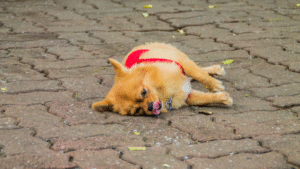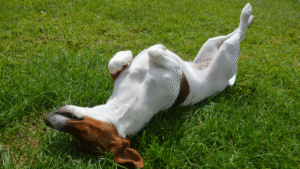“Play dead” is one of the cutest and most impressive dog tricks you can teach. If you want to learn how to train your dog to play dead, we’ve got you covered! In this comprehensive step-by-step guide, we’ll explain everything you need to know — from preparation to helpful commands and troubleshooting.
Playing dead not only keeps your dog entertained but also improves their obedience, focus, and problem-solving skills.
We’ll also share some fun variations of the trick and explain why positive reinforcement is the most important part of training.

Why Teach Your Dog to Play Dead?
Before we begin the training process, let’s first look at why it’s beneficial to teach your dog tricks.
Playing dead (like other tricks) offers several valuable benefits:
Helps with Obedience and Focus
Teaching tricks requires you to give your dog a sequence of commands. They must listen carefully, focus on you, and respond only to your cues. Training like this strengthens their impulse control, problem-solving skills, and responsiveness.
Strengthens Your Bond
Dog training builds trust and clear communication between you and your pet. The more time you spend teaching and practicing tricks, the closer your relationship becomes.
Provides Mental Stimulation
Both physical and mental exercise are crucial for your dog’s well-being. Training and learning new tricks keep their minds sharp, preventing boredom and unwanted behaviors such as chewing or digging.
Builds Confidence
Positive reinforcement during training helps your dog feel confident in their abilities. This confidence often carries over into other aspects of life.
A Great Party Trick
Let’s face it — “play dead” is an excellent trick to show off! It’s hard not to smile when a dog dramatically flops onto the ground on command.
What to Prepare Before Training
Before you begin, make sure you have these essentials ready:
-
Quiet training space: Choose a distraction-free environment for the best results.
-
Tasty treats: Use small, soft treats that your dog can’t resist. Try a variety of flavors so your dog doesn’t lose interest. Positive reinforcement is key.
-
Clicker (optional): Clicker training can be a very effective way to reinforce desired behaviors.
-
Patience and consistency: Dog training takes time. Don’t expect instant results — every dog learns at their own pace. Some will pick it up quickly, while others may take days or even weeks.
If your dog already knows the “lie down” command, you’re halfway there. If not, spend time teaching it before moving on to the next steps.

How to Teach Your Dog to Play Dead in 6 Steps
Step 1: Start with “Lie Down”
Begin with your dog lying down on the floor using the “lie down” command or a hand signal.
Reward your dog once they’re in the correct position.
Since the “play dead” trick starts from this position, it’s crucial that your dog feels comfortable lying flat.
Step 2: Lure Them onto Their Side
Once your dog is lying down, hold a treat close to their nose and slowly move it toward their shoulder or hip to encourage them to roll onto their side.
As soon as your dog rolls over and stays on their side — even for a second — reward and praise them.
Repeat this a few times until your dog understands that lying on their side earns a treat.
Step 3: Add the Verbal Cue
Once your dog responds to the lure consistently, introduce a verbal cue. Common options include:
-
“Bang!”
-
“Play dead!”
-
“Go down!” or “Sleep!”
Pick one cue and be consistent. Use it right before your dog rolls onto their side. Over time, they’ll associate the cue with the action.
Step 4: Add a Hand Signal (Optional)
Dogs are excellent at reading body language. You can reinforce the trick by adding a hand signal, such as pointing a finger gun or sweeping your hand downward.
Consistency is key — always use the same gesture alongside the same verbal cue.
Step 5: Increase the Duration
Once your dog is comfortable rolling onto their side, gradually extend the time they stay in that position before rewarding them. Start with one second, then build up to five, ten, or even twenty seconds.
You can also make the trick more realistic by rewarding your dog for staying still and “lifeless.” The less movement, the more convincing the performance will look.
Step 6: Reduce the Treats
After your dog consistently performs the trick, start phasing out the treats.
Instead of rewarding every successful attempt, switch to verbal praise or petting.
You don’t want your dog to perform only when they see food — they should respond even without a visible treat.

Troubleshooting Common Problems
Even with consistent training, you might encounter a few challenges. Here’s how to handle them:
Dog Won’t Roll Over Completely
If your dog seems hesitant, use smaller lures and reward partial progress. For instance, if your dog leans onto their side but doesn’t fully roll over, reward that movement until they’re more comfortable.
Dog Gets Too Excited
Some dogs become overly enthusiastic when they see treats. If that happens, pause the session, allow your dog to calm down, and reward relaxed behavior before resuming training.
Dog Loses Interest
Keep training sessions short — no longer than 5–10 minutes. Dogs learn best with short, consistent sessions rather than long ones.
Dog Confuses “Play Dead” with “Roll Over”
Be clear and consistent with your cues. Use distinct verbal commands and hand signals for each trick.
Helpful Training Tips
To make your training experience more effective and enjoyable, keep these tips in mind:
-
Be patient: Every dog learns at a different pace. Some will master the trick quickly, while others may take longer. Stay patient and persistent.
-
End on a positive note: Always finish training on success. Reward your dog for effort, even if they haven’t fully perfected the trick.
-
Use a release command: Teach a release word like “Okay” or “Up” so your dog knows when they can move.
-
Keep it fun: Training should be enjoyable. Your dog will learn faster if they view it as a game, not a chore.

Variations of the Trick
Once your dog has mastered the basic “play dead,” you can add fun variations:
-
Dramatic “Bang!” Scene: Pretend to “shoot” your dog with a finger gun and watch them drop dramatically.
-
Sleeping Dog: Teach your dog to rest their head on the floor as if they’ve fallen asleep.
-
Zombie Dog: Combine “play dead” with “crawl” so your dog slowly creeps forward like a zombie.
These variations make training even more engaging and provide additional mental stimulation.
Why Positive Reinforcement Is Important
Positive reinforcement is the cornerstone of effective dog training. Rewarding good behavior with praise, treats, or a clicker helps your dog form a positive association with the desired action, making them eager to repeat it.
Punishment or negative reinforcement, on the other hand, can create confusion or fear. If your dog doesn’t understand the trick, don’t show frustration. Instead, reward small progress and stay calm and encouraging.
When Should You Train?
The best time to train is when your dog is calm and alert. Avoid sessions right after meals, when they’re overly tired, or when they’re too energetic.
Mid-morning or mid-afternoon is often ideal. Aim for one or two short sessions a day, about ten minutes each.
Regular, short sessions are far more effective than infrequent long ones.
Beyond the Trick: Why Training Is Beneficial
Once your dog masters “play dead,” you’ll notice improvements in their overall obedience and communication. Trick training develops:
-
Better impulse control
-
Improved body awareness
-
Increased trust and cooperation
-
Enhanced responsiveness to cues
These benefits carry over into everyday life, making your dog better behaved and more attentive.
Final Thoughts
Teaching your dog to play dead isn’t just about showing off a cute trick — it’s an enjoyable way to bond with your pet and improve their skills. It requires minimal preparation and only a few focused sessions to master.
The keys to success are patience, consistency, and positive reinforcement. Keep sessions short, fun, and rewarding, and your dog will soon be performing this crowd-pleasing trick with confidence.
- 5 Cheap Alternatives To Dog Training Equipment - November 12, 2025
- Homemade Calming Spray To Help Dogs During Training - November 12, 2025
- 7 DIY Dog Training Tools You Can Make From Household Items - November 12, 2025
